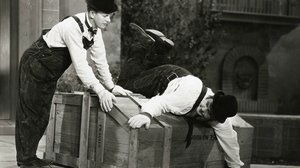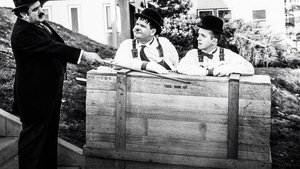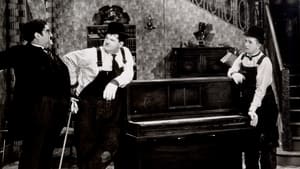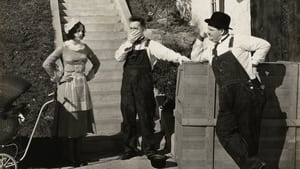Contact: info@alwanfilm.com
Video Sources 0 Views
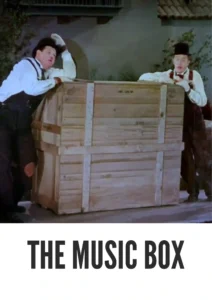
The Music Box 1932 Colorized
Synopsis
Review: The Music Box 1932 Colorized – A Timeless Classic in Comedy Cinema

Introduction
In the annals of cinematic history, few films have stood the test of time quite like “The Music Box” (1932). Directed by James Parrott and starring the legendary comedy duo Laurel and Hardy, this short film has become an enduring symbol of classic slapstick comedy. Released during the Great Depression, “The Music Box” not only provided much-needed laughter but also showcased the timeless appeal of physical comedy. In this article, we will delve into the significance of “The Music Box,” its impact on the genre, and why it remains a beloved classic to this day.
Check The Full Colorized Movies List
Check Our Colorized Movies Trailer Channel
Understanding The Music Box 1932 Colorized: Director, Cast, and Genre
“The Music Box” was directed by James Parrott, a prolific filmmaker known for his work in the comedy genre during the silent and early sound eras. The film stars Stan Laurel and Oliver Hardy, whose chemistry and comedic timing have cemented them as one of the greatest comedy duos in film history. Released in 1932, the film falls squarely within the slapstick comedy genre, characterized by physical humor, exaggerated situations, and minimal dialogue.
Parrott’s direction captures the essence of Laurel and Hardy’s comedic style, emphasizing visual gags and physical mishaps. The simplicity of the plot—a pair of bumbling movers attempting to deliver a piano—serves as the perfect canvas for their comedic talents, allowing the duo to shine through their expressive performances and impeccable timing.
Exploring the World of The Music Box 1932 Colorized: Plot and Characters
At its core, “The Music Box” follows the misadventures of two inept piano movers, played by Laurel and Hardy, as they attempt to deliver a piano to a house at the top of a long flight of stairs. The plot, while straightforward, is a masterclass in comedic timing and physical humor. The film’s genius lies in its ability to extract maximum laughs from the simplest of scenarios, transforming mundane tasks into epic, laugh-out-loud struggles.
Stan Laurel’s character, Stan, is the quintessential bumbling fool, characterized by his childlike innocence and perpetual bewilderment. Oliver Hardy, as Ollie, plays the more pompous and self-assured counterpart, whose overconfidence invariably leads to disaster. Together, they create a dynamic that is both endearing and hilarious, as their well-meaning efforts are thwarted by a series of increasingly absurd obstacles.
The Art of Slapstick Comedy
Slapstick comedy, a genre rooted in exaggerated physical humor, has been a cornerstone of cinematic entertainment since the early days of film. Its appeal lies in its universal nature, transcending language and cultural barriers to elicit laughter through visual gags and physical mishaps. “The Music Box” epitomizes the art of slapstick, with its meticulously choreographed sequences and inventive use of props.
The genre’s reliance on physicality demands a high level of skill and precision from its performers. Laurel and Hardy’s mastery of slapstick is evident in their seamless execution of pratfalls, double-takes, and sight gags. Their ability to convey emotion and narrative through movement and expression, rather than dialogue, underscores the enduring power of physical comedy.
The Evolution of Comedy in Early Cinema
The evolution of comedy in early cinema is a testament to the genre’s adaptability and resilience. From the silent film era, dominated by the likes of Charlie Chaplin and Buster Keaton, to the advent of sound, comedy has continuously reinvented itself to captivate audiences. “The Music Box” occupies a unique place in this lineage, bridging the gap between silent and sound comedy with its clever use of sound effects and synchronized gags.
Early comedians like Chaplin and Keaton paved the way for Laurel and Hardy, who built upon their predecessors’ foundations while adding their distinct brand of humor. The transition from silent to sound film allowed for more sophisticated comedic setups and punchlines, as evidenced in “The Music Box.” The film’s ingenious use of diegetic sound—such as the piano’s off-key notes and the characters’ grunts and groans—enhances the comedic impact, demonstrating the potential of sound in amplifying physical humor.
The Music Box 1932 and Its Timeless Appeal
The enduring appeal of “The Music Box” lies in its simplicity and universality. The film’s premise—a straightforward delivery job gone hilariously wrong—resonates with audiences of all ages and backgrounds. Its humor is rooted in the fundamental human experience of struggle and perseverance, themes that are both relatable and timeless.
Moreover, “The Music Box” showcases the impeccable chemistry between Laurel and Hardy, whose performances transcend the constraints of time and technology. Their comedic genius is evident in every gesture and expression, creating a timeless connection with viewers. The film’s influence can be seen in subsequent generations of comedians and filmmakers, who continue to draw inspiration from its brilliant execution of slapstick comedy.
The Debate Over Slapstick’s Place in Modern Comedy
While slapstick comedy has waned in popularity in contemporary cinema, its legacy remains undeniable. The debate over slapstick’s relevance in modern comedy often centers on its perceived simplicity and reliance on physical gags. Critics argue that the genre lacks the narrative depth and sophistication of more dialogue-driven forms of comedy.
However, proponents of slapstick point to its universal appeal and ability to evoke genuine laughter without relying on verbal wit or cultural references. In an era dominated by complex plotlines and rapid-fire dialogue, slapstick offers a refreshing return to the basics of comedy: physicality, timing, and visual storytelling. “The Music Box” serves as a potent reminder of the enduring power of slapstick to elicit laughter and joy.
Examining The Music Box 1932 Colorized as a Masterpiece of Slapstick
Viewing “The Music Box” through the lens of slapstick mastery reveals the film’s intricate choreography and meticulous attention to detail. Every gag is carefully crafted to maximize comedic effect, from the precarious balancing acts to the inevitable tumbles. The film’s pacing, a crucial element in comedy, is executed with precision, allowing each joke to land with perfect timing.
The simplicity of the plot—a piano delivery up a seemingly endless flight of stairs—belies the complexity of the comedic sequences. Laurel and Hardy’s physical performances are a testament to their skill and dedication, as they navigate the absurd obstacles with impeccable timing and coordination. Their ability to turn mundane tasks into epic comedic set pieces underscores their status as masters of the genre.
Influence and Legacy: The Music Box 1932 Colorized’s Impact on Cinema
“The Music Box” has left an indelible mark on the history of cinema, influencing countless comedians and filmmakers. Its impact can be seen in the work of subsequent generations, from the physical comedy of Lucille Ball and Carol Burnett to the slapstick-infused antics of contemporary performers like Jim Carrey and Rowan Atkinson.
The film’s legacy extends beyond the realm of comedy, serving as a touchstone for filmmakers exploring the potential of visual storytelling. Its innovative use of physical humor and sound effects has inspired directors across genres, demonstrating the power of simplicity and timing in creating memorable cinematic moments. “The Music Box” stands as a testament to the enduring influence of Laurel and Hardy, whose comedic genius continues to resonate with audiences around the world.
Director’s Cinematic Legacy: Beyond The Music Box 1932 Colorized
James Parrott’s contribution to the comedy genre extends beyond “The Music Box,” encompassing a body of work that highlights his talent for crafting memorable comedic moments. While he may not be as widely recognized as some of his contemporaries, Parrott’s direction in “The Music Box” showcases his skill in orchestrating complex physical comedy with precision and flair.
Parrott’s collaborations with Laurel and Hardy produced several classic films, each characterized by their inventive use of physical humor and visual gags. His ability to balance the comedic talents of the duo with the demands of storytelling underscores his importance in the evolution of comedy in early cinema.
Themes Explored in The Music Box 1932 Colorized
At its heart, “The Music Box” explores themes of perseverance, resilience, and the absurdity of everyday struggles. The film’s humor is rooted in the universal human experience of facing obstacles and overcoming challenges, often with a sense of bemusement and frustration. Through their misadventures, Laurel and Hardy capture the essence of the human condition, highlighting the comedic potential in life’s trials and tribulations.
The film’s central theme of perseverance is embodied in the duo’s relentless efforts to deliver the piano, despite the seemingly insurmountable odds. Their determination in the face of repeated failure resonates with audiences, offering a humorous yet poignant reflection on the nature of persistence and the inevitability of setbacks.
Reception and Controversy Surrounding The Music Box 1932 Colorized
Upon its release, “The Music Box” was met with widespread acclaim, earning praise for its inventive humor and masterful performances. The film’s success was further cemented when it won the first Academy Award for Best Live Action Short Film (Comedy) in 1932, a testament to its impact and popularity.
Despite its accolades, “The Music Box” has not been without controversy. Some critics have argued that the film’s humor relies too heavily on physical gags and lacks the narrative complexity of other comedic works. However, these critiques are often countered by the film’s enduring popularity and the continued appreciation of its slapstick brilliance.
Where to Watch The Music Box 1932 Colorized Online
For those eager to experience the timeless charm of “The Music Box,” the film is readily available on various streaming platforms and classic film archives. It can be found on popular services such as Amazon Prime Video, Criterion Channel, and YouTube, ensuring that audiences can enjoy this comedic gem from the comfort of their homes.
FAQs About The Music Box 1932 Colorized
Common queries surrounding “The Music Box” often pertain to its production, legacy, and the enduring appeal of Laurel and Hardy’s comedy. Here are some frequently asked questions about the film:
Q: What inspired the plot of “The Music Box”?
A: The plot was inspired by a simple yet relatable scenario: the delivery of a heavy piano. This mundane task provided the perfect backdrop for Laurel and Hardy’s comedic talents, allowing them to transform an ordinary situation into a series of hilarious misadventures.
Q: Why is “The Music Box” considered a classic?
A: “The Music Box” is considered a classic due to its masterful execution of slapstick comedy, the impeccable chemistry between Laurel and Hardy, and its influence on subsequent generations of comedians and filmmakers. Its timeless humor and universal themes continue to resonate with audiences today.
Q: How did “The Music Box” impact Laurel and Hardy’s careers?
A: “The Music Box” solidified Laurel and Hardy’s status as icons of comedy, earning them critical acclaim and a dedicated fanbase. The film’s success paved the way for more collaborations between the duo and director James Parrott, further cementing their legacy in the annals of cinematic history.
Conclusion
In conclusion, “The Music Box” (1932) stands as a timeless testament to the enduring power of slapstick comedy. Directed by James Parrott and featuring the incomparable duo of Laurel and Hardy, the film continues to captivate audiences with its simple yet brilliant humor. As we reflect on the legacy of “The Music Box,” it becomes clear that its charm lies not in its complexity, but in its ability to find humor in the everyday struggles of life.
Whether experienced in its original black and white format or through the lens of modern technology, “The Music Box” remains a cherished classic, reminding us of the universal appeal of laughter and the timeless joy of comedy. As we continue to navigate the ever-changing landscape of cinema, let us celebrate the enduring legacy of “The Music Box” and the comedic genius of Laurel and Hardy, whose performances continue to bring smiles to faces around the world.
